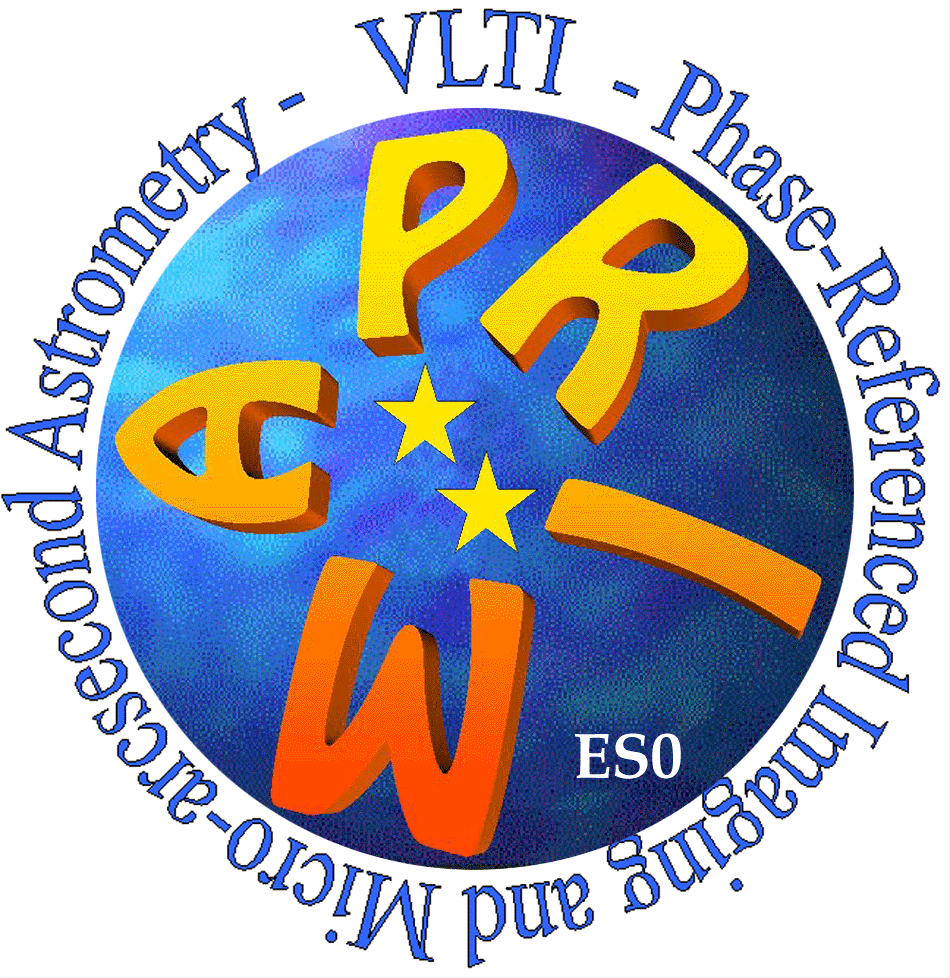PRIMA Overview
The Phase Referenced Imaging and Micro-arcsecond Astrometry (PRIMA)project is currently being developed by the European Southern Observatory (ESO) and being installed on the Very Large Telescope Interferemeter (VLTI)on Cerro Paranal in Chile.The objective of PRIMA is to enable simultaneous interferometric observations of two objects - each with a maximum size of 2 arcsec - that are separated by up to 1 arcmin,without requiring a large continuous field of view.
PRIMA will enhance the VLTI in three key areas:
- Sensitivity, the limiting magnitude can be shifted from K= 10-13 (respectively for the ATs and the UTs ) to K=13-16
- Imaging of faint objects with high angular resolution (<10 milli arcsec)
- High precision astrometry (<10 micro arcsec) to allow planet detection
The principle of operation relies on finding within the isoplanatic angle (~1 arcmin) of the science target a sufficiently bright star that can be used as a reference star for the measurement and the stabilisation of the fringe motion induced by atmospheric turbulence.This operation mode brings faint objects within reach. Controlling additionally all optical path lengths of the reference star and of the science star inside the interferometer with a laser metrology system introduces the capability of imaging faint objects and of determining the precise angular separation between the two stars.
PRIMA and its Sub-systems
PRIMA can be subdivided into four sub-systems:
The Star Separator : An optical system for the UTsand ATs located in the Coude Foci that feeds two arbitrary objects from the Coude field of view into the delay lines of the VLTI.
The Laser Metrology System: To monitor with high accuracy (5 nm rms) the internal OPD between object and reference star.The laser beam is fed into the VLTI optics in the beam combination laboratory and travels along the same path as the star light up to the secondary mirror where a retro reflector sends the light back to the beam combination laboratory.
The Differential Delay Lines: The difference between the white light fringe position of the object and the one oft he reference star can be expressed as a differential OPD. The differential delay lines will be installed in the beam combination laboratory.
The Fringe Sensor Unit: An infrared camera measuring the position of the white light fringe providing the error signal for the fringe tracking system (FSU B). The fringe sensor unit is located in the beam combination laboratory. An identical device (FSUA) will play the role of Astrometry Detector A for astrometric measurements allowing the observation of the fringe patterns of the secondary star on the same detector.
Science with PRIMA
The scientific potential of PRIMA is huge and covers stellar as well as extra-galactic topics:
- Star formation - determining the duplicity of massive stars in young open clusters, stars in late stages of evolution - observing the immediate vicinity and the surfaces of far evolved stars yielding information on stellar atmospheres and mass loss, stellar dynamics- measurements of differential proper motions between stars in globular clusters,
- Quasars and active galactic nuclei - investigating the nature of the relative contributions of a circumnuclear starburst and a compact nuclear source,
- Extra galactic astrometry - determining the so-called AGN Dance-centroid due to SN explosion.
- The galactic center- the galactic center will be a target for imaging as well as for astrometry. The main goals are the search for a counterpart of the radio source Sgr A*, the very center of our galaxy, which is difficultat lower spatial resolutions because of severe crowding, and the measurement of radial velocities and proper motions of individual stars in the Galactic Center cluster providing strong arguments for the presence of a massive black hole in the center of our Galaxy,
- Substellar companions and planet detection.The situation in the area of the search of substellar companions and planet detection has changed drastically over the last few years with the discovery, mostly with radial-velocity techniques, of more than a dozen substellar objects.The sensitivity of these techniques is limited for separations lower than 2AU and they only provide a measurement of the minimum mass of the companion, leaving uncertainties on the real nature of the detected companions. Determining the very low mass companions is a key issue for understanding if there is a critical mass separating giant planets from brown dwarfs. The astrometric accuracy of PRIMA allows us to easily detect Jupiter and Saturn-like planets.

